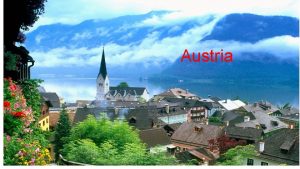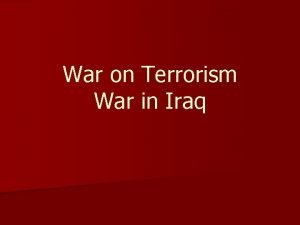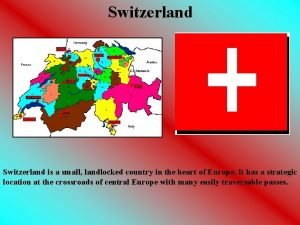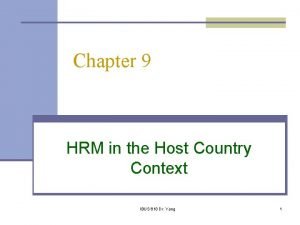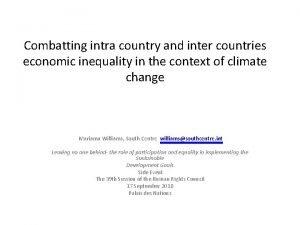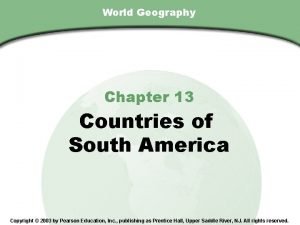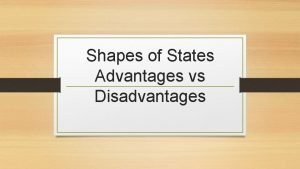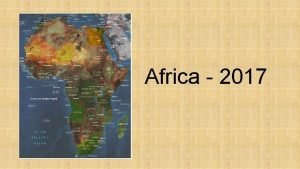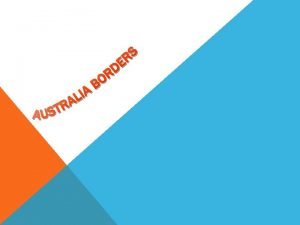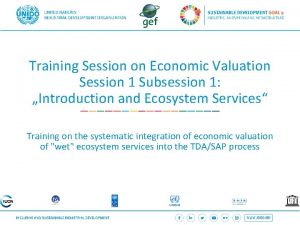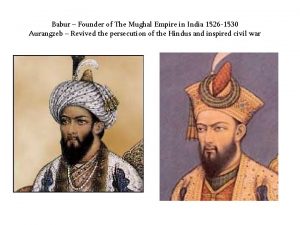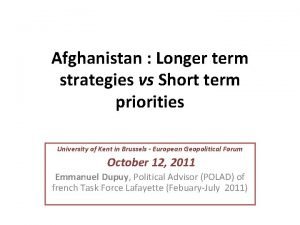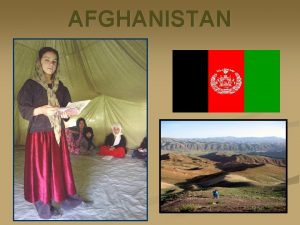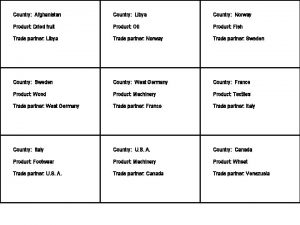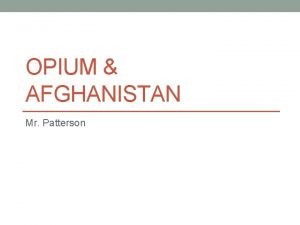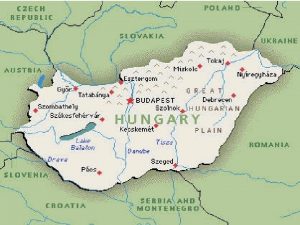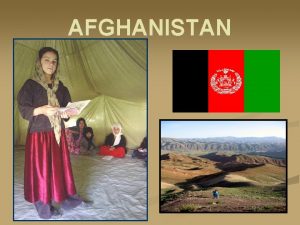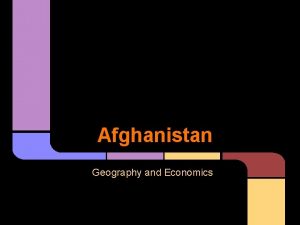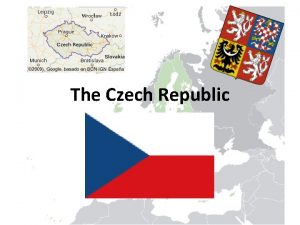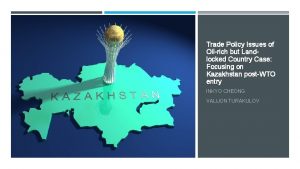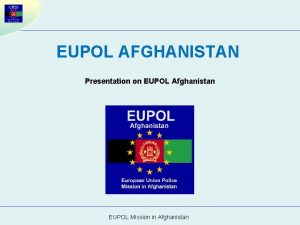Afghanistan Geography Afghanistan is a landlocked country making















- Slides: 15

Afghanistan

Geography • Afghanistan is a landlocked country, making the export of goods difficult and expensive. • It has rugged mountains and plains and is prone to natural disasters such as earthquakes and drought. • Temperatures are extreme, as hot as 120° F in the summer and as cold as -15° F in the winter. • There are limited natural fresh water sources, and most of the land has been overgrazed and deforested, causing desertification and soil degradation, making farming difficult.

Geography Photo by U. S. Army 10 th Mountain Division-Light Infantry Afghanistan is a landlocked country. It is very dry and has extremely warm summers and very cold winters. The mountains are rugged, although there are some plains used for farming.

Important Facts • Capital: Kabul • Area: 251, 825 sq mi; slightly smaller than Texas • Population: 31, 056, 997 (July 2006 estimate) 80% Sunni Muslim, 19% Shia Muslim (*Taliban & Al Qaeda are Sunni Muslims) • Main ethnic groups: Pashtun, Tajik, Hazara, Uzbek • GDP per capita: purchasing power parity - $800 (2004 estimate) • Over 80% of labor force is employed in agriculture (farming, sheep, goats) • Covered by an estimated 5 -7 million landmines • Leading illicit opium producer in 2005 supplying 89% of the opium produced in the world. 1/3 of the GDP comes from opium trade

History • In 1979, Afghanistan was invaded and eventually controlled by the Soviet Union. • In 1989, Afghanistan and the Soviet Union signed a peace agreement. • In 1995, the Taliban, promising traditional, Islamic values came into power, imposing strict Islamic law, including revoking many women’s rights. • In 2001, American troops force the Taliban from power. • In 2004, Hamid Karzai became the first elected Afghan president.

Government: The Taliban Prior to 2001, the Taliban, led by Mullah Mohammad Omar, ruled Afghanistan under Islamic law. During this time: • women had virtually no rights and received no education. • Watching television, listening to music and playing games and sports were forbidden The United States entered Afghanistan in October 2001 and replaced the Taliban with an elected president. While the Taliban lost some power and the people regained some rights, the Taliban has not gone away. Instead, it has worked to regain power by promising to help Afghanistan’s poorest people and aligning itself with warlords, al. Qaida, and other militant groups to gain financial support and recruit new fighters. Taliban Leader Mullah Mohammad Omar

Government: The Taliban The militant Islamic terrorist network known as al-Qaida and led by Osama bin Laden, was based in Afghanistan for many years prior to U. S. attacks on the organization in October 2001 following the Sept. 11, 2001 terrorist attacks. The organization continues to grow, but bin Laden was killed in May 2011.

Government: President Karzai President Hamid Karzai was the first elected president in the history of Afghanistan. He came to power after the Taliban was overthrown in late 2001. He was formally elected to a five-year term in 2004. Karzai has survived numerous assassination attempts and has been assigned the task of rebuilding Afghanistan. Some of the major problems he must address include providing the country with an infrastructure so that citizens have the basic necessities of life, keeping the Taliban out of power and controlling the warlords who perpetuate the illegal drug trade.

The People Pashtun: largest ethnic group, mostly farmers and Sunni Muslims Tajik: live mostly in the northeast, second largest ethnic group, mostly Sunni Muslims Hazara: live in the Hindu Kush mountains, primarily Shiite Muslims Uzbek: live mostly along the northern border, mostly Sunni Muslims Aimaqs: a farming and herding tribe in the west, mostly Sunni Muslims Turkmen and Kirghiz: nomadic herders and craftsmen, mostly Sunni Muslims Baluch: nomadic tribe living in the southern deserts, Sunni Muslims

The People The Afghan people are some of the poorest in the world and are members of many different ethnic groups. This woman is part of a herding tribe and is drying dung to use as insulation in her home during the winter. Life is difficult for most Afghans as they have faced drought, famine and war for many years.

The lives of the Afghan people differ from ours in many ways. Above, a 16 -year-old girl works at sewing for about $1 a day as part of a special training program. U. S. soldiers are a common sight in Afghanistan and often interact with the local people. The picture on the lower right shows an Afghan school, where students sit in on the floor waiting for the day’s lessons to begin.

This woman works the land to make it suitable for planting as part of a work-for-food program aimed at helping Afghanistan increase its agricultural production. As part of their religious belief system, Afghan women cover themselves as a show of modesty, showing only their hands and faces. Men are also expected to cover from navel to knees.

Important Issues Afghanistan employs 80 percent of its workforce in farming or raising sheep and goats. Because it is a landlocked country with mountainous terrain, exporting goods like the melons carried by the boy is difficult and expensive. Poppies are grown illegally as a source of opium, which is used to produce heroin. Drug lords make millions through unregulated trade of this drug. The Afghan government is working to eliminate illegal drug trade and encourage the growth of other agricultural crops for export.

Afghanistan at a Glance • • • Only 23% of the population has access to safe water Only 12% have access to adequate sanitation, thereby increasing the incidence of diseases. At least 15, 000 Afghans die of tuberculosis every year, of which 64% are women. The poor health situation has been aggravated by the lack of basic health services and resources, particularly in rural areas; the strict segregation of medical staff and the small number of trained women doctors, nurses and midwives that remained in the country after the rise of the Taliban. 23 years of war have destroyed the infrastructure of the educational system and further increased the illiteracy rate in Afghanistan. Only 5 % of women are able to read and write (during the 1980 s, the female adult literacy rate was only 8 %). 54 % of girls under the age of 18 are married. Families of girls and young women were reportedly forced to marry them to the Taliban or give them large amounts of money instead. Often, families married young girls at an earlier age in order to use the bride price to assist in the family's survival. The conflict in Afghanistan during the Taliban rule and the militarization of society led to an increased number of abductions of young girls and women by Taliban fighters. The exact numbers are unknown, as families have been reluctant to come forward and report cases of abductions for fear of reprisals.

Talib: “student”/soldiers of the Taliban
 Austria is a landlocked country
Austria is a landlocked country Is iraq a landlocked country
Is iraq a landlocked country Is czech republic landlocked
Is czech republic landlocked A small landlocked country in central europe
A small landlocked country in central europe Host country and home country
Host country and home country Intra country vs inter country
Intra country vs inter country What is landlocked
What is landlocked Disadvantages of elongated states
Disadvantages of elongated states Landlocked countries in africa
Landlocked countries in africa Is australia landlocked
Is australia landlocked Is indonesia landlocked
Is indonesia landlocked Is making inference simply making a guess
Is making inference simply making a guess War making and state making as organized crime
War making and state making as organized crime Afghanistan
Afghanistan Prime minister of afghanistan
Prime minister of afghanistan Toward pakistan be all about afghanistan
Toward pakistan be all about afghanistan
